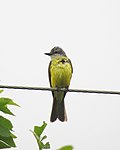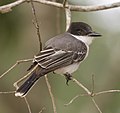Kingbird
| Kingbirds | |
|---|---|

| |
| Eastern kingbird (Tyrannus tyrannus) | |
| Scientific classification | |
| Domain: | Eukaryota |
| Kingdom: | Animalia |
| Phylum: | Chordata |
| Class: | Aves |
| Order: | Passeriformes |
| Family: | Tyrannidae |
| Genus: | Tyrannus Lacépède, 1799 |
| Type species | |
| Lanius tyrannus | |
| Species | |
|
See text. | |
Tyrannus is a genus of small passerine birds of the tyrant flycatcher family. The majority are named as kingbirds.
They prefer semi-open or open areas. These birds wait on an exposed perch and then catch insects in flight.[1] They have long pointed wings and large broad bills. These birds tend to defend their breeding territories aggressively, often chasing away much larger birds. A kingbird was photographed in 2009 defending its young by landing on and sinking its talons into the back of a red-tailed hawk and pecking its skull until the red-tailed hawk gave up and flew away.[2]
The genus was introduced in 1799 by the French naturalist Bernard Germain de Lacépède with the eastern kingbird (Tyrannus tyrannus) as the type species.[3] The genus name is the Latin word for 'tyrant'.[4]
Species
The genus contains 13 species:[5]
| Image | Common Name | Scientific name | Distribution |
|---|---|---|---|
 |
Snowy-throated kingbird | Tyrannus niveigularis | Colombia, Ecuador, and Peru |
 |
White-throated kingbird | Tyrannus albogularis | Bolivia, Brazil, Colombia, Ecuador, Peru, and Venezuela, and in the Guianas of Guyana, Suriname and French Guiana |
 |
Tropical kingbird | Tyrannus melancholicus | Southern Arizona and the lower Rio Grande Valley of Texas in the United States through Central America, South America as far south as central Argentina and western Peru, and on Trinidad and Tobago |
 |
Couch's kingbird | Tyrannus couchii | Southern Texas along the Gulf Coast to the Yucatán Peninsula in Mexico, Belize and northern Guatemala. |
 |
Cassin's kingbird | Tyrannus vociferans | California and from Montana to Utah, along the eastern Rocky Mountains, and northern Central America |
 |
Thick-billed kingbird | Tyrannus crassirostris | Southeastern Arizona, extreme southwestern New Mexico, and northern Sonora, (the Madrean sky islands), in the United States and Mexico, through western and western-coastal Mexico, south to western Guatemala. |
 |
Western kingbird | Tyrannus verticalis | Florida and the Pacific coast of southern Mexico and Central America. |
 |
Scissor-tailed flycatcher | Tyrannus forficatus | Texas, Oklahoma, Kansas; western portions of Louisiana, Arkansas, and Missouri; far eastern New Mexico; and northeastern Mexico |
 |
Fork-tailed flycatcher | Tyrannus savana | Central Mexico to central Argentina |
 |
Eastern kingbird | Tyrannus tyrannus | Open areas across North America |
 |
Gray kingbird | Tyrannus dominicensis | United States, mainly in Florida, through Central America, from Cuba to Puerto Rico as well as eastward towards all across the Lesser West Indies, south to Venezuela, Trinidad, Tobago, the Guiana, and Colombia. |
 |
Giant kingbird | Tyrannus cubensis | Cuba |
 |
Loggerhead kingbird | Tyrannus caudifasciatus | The Bahamas, Cayman Islands, Cuba, the Dominican Republic, Haiti, Jamaica, Puerto Rico, and, very rarely, in the United States. |
References
- ^ Kannan, R.; James, D.A. (2011). "Foraging behavior of three sympatric and congeneric Tyrannid flycatchers (Tyrannus spp.) in western Arkansas". Journal of the Arkansas Academy Science. 65 (1): 169–172. doi:10.54119/jaas.2011.6520. S2CID 53340074.
- ^ "Kingbird rides on back of hawk to defend young". telegraph.co.uk. 2009-10-30. ISSN 0307-1235. Retrieved 2018-10-25.
- ^ Lacépède, Bernard Germain de (1799). "Tableau des sous-classes, divisions, sous-division, ordres et genres des oiseux". Discours d'ouverture et de clôture du cours d'histoire naturelle (in French). Paris: Plassan. p. 5. Page numbering starts at one for each of the three sections.
- ^ Jobling, James A. (2010). The Helm Dictionary of Scientific Bird Names. London: Christopher Helm. p. 394. ISBN 978-1-4081-2501-4.
- ^ Gill, Frank; Donsker, David, eds. (2017). "Tyrant flycatchers". World Bird List Version 7.3. International Ornithologists' Union. Retrieved 9 January 2018.
